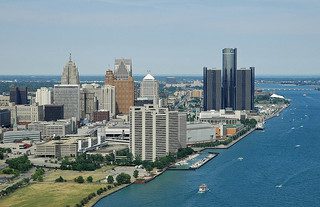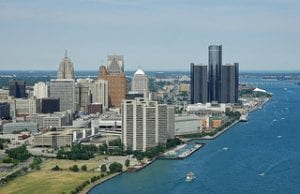Last Thursday, I was listening to Bruce Katz on NPR talk about Detroit’s recent bankruptcy and the set of metropolitan-oriented strategies/practices that he thinks represents the way forward for the troubled city.
Before I get too deep into my critique and thoughts about economic development and poverty and race, I want to note that I agree with what most of what Katz’s thesis that metro regions are the locus of technological innovation, economic growth, etc., and that if you want to impact the economy at any geographic scale (whether local or national), you have to think and act at a regional level.
But, as Kaid Benfield discusses in his excellent rumination on Brooking Institution’s metropolitan approach and the future of community development, you can agree with Katz about the workings of economies but still not share his optimism about whether the tide of metro economic growth, in and of itself, lifts up all boats.
Did Detroit Get Poorer—Or Just Less Rich?
Per the decennial Census, Detroit city’s population peaked in 1950 at almost 1.85 million. By 2010, Detroit’s population was slightly over 0.71 million. Everybody knows this story. What is more interesting (to me at least) is to look at the population in poverty over roughly the same period, in roughly the same area.
In 1960 (the poverty level is a 1960s construct and I couldn’t find equivalent data for 1950), Wayne County had approximately 430,000 people in poverty. In 2010, Wayne County had approximately 395,000 people in poverty. Over the past 50 years, the number of people in poverty in Wayne County has fluctuated between approximately 300,000 to 400,000. Despite the popular narrative, Detroit didn’t get poorer as much as it got less rich. That is, as Detroit has been depopulating, the number of people in poverty has stayed roughly the same. It’s a tale of two Detroits, one rich, the other poor. It’s as if, while one Detroit pulled up stakes and left, the other got left behind.
Should Detroit Try to be Silicon Valley?
Amongst the engineering set, “Silicon Valley” became a term to describe Santa Clara County sometime during the early 1970s. Silicon Valley became a more widely used moniker as computer technology boomed in the 1980s, as the former agricultural area grew from being a bedroom community into the technological center of the leading industry of the nation and home to some of the largest companies in the world—much as Detroit was in its heyday.
The rise of Silicon Valley has been roughly concurrent to Detroit’s decline. From 1950 to 2010, Silicon Valley picked up roughly as many residents as Detroit lost. And in 2010, Wayne County and Santa Clara County had roughly the same total population. In 2000, San Jose, the largest city in Santa Clara County, was the 11th most populous in the country while Detroit was the 10th. In 2010, San Jose was the 10th most populous in the country while Detroit had dropped to 18th.
And beyond this Lincoln’s-secretary-was-named-Kennedy-and-Kennedy’s-secretary-was-named-Lincoln economic/demographic analysis of Detroit and Silicon Valley, the imagined economic fates of the two regions are intertwined in the theoretical imaginings of the economic development set.
Much of the metropolitan regionalists’ thinking about regions and economic development —the roles of clusters of firms across a region, of the practices, infrastructure, and approach to human capital development that lead to innovation, the role of government and universities and social institutions—have come from observations about Silicon Valley. Emerging economic hubs like North Carolina’s Research Triangle, in their quest to be the next Silicon Valley, replicate and adapt these strategies.
The way up for Detroit, therefore, is to become more like Silicon Valley.
I have no doubt that if Detroit grows again economically in any significant way it will be because it has (re)invigorated a regional ecosystem around a cluster of firms in an innovative, growing technology/industry. I believe the metro regionalist message about how economies innovate and grow.
But my critique and question is, what does this mean for poor people? Looking at the demographic history of poverty in Silicon Valley is instructive. In 1960, there were approximately 65,000 poor people in Santa Clara County. In 2010, there were over 150,000 poor people in Santa Clara County. From 1970 to 2000, Santa Clara County’s poverty rate was roughly stable, meaning that the poverty population grew more or less in proportion to the overall population. So, while the economy of Silicon Valley has grown, so has its poverty population.
Silicon Valley has its own version of the tale of two cities, of long hours at low-wage service industry jobs, of increasing costs of living (particularly housing), of invisibility in the face of growing affluence, of longer commutes, of declining public services, and of being priced out of the regional market. The poor who live and work in Silicon Valley know very well that having a growing economy, in and of itself, does not solve poverty.
A growing economy probably makes it easier to address poverty (more likely to have the resources and maybe the political will to do something and a more vibrant economy creates more opportunities for economic mobility) but a growing economy is far from a magic bullet for poverty. Full investment in a broad range of direct and purposeful strategies—social services, affordable housing, job development, job training, employment programs, education and afterschool programs, childcare, healthcare, income subsidies, micro-enterprise assistance, asset building, legal aid, community infrastructure, public transit, housing counseling (in short, the social/economic safety net that is currently being cut) are still necessary to help improve the lives of poor people and provide meaningful pathways out of poverty. And even then, I don’t think we will ever solve poverty.
A Rising Tide Doesn’t Lift All Boats
At this point, I’ve gone on for about 1,000 words to split a fairly nuanced hair. To condense my message so far: I agree that a metro/regional frame is right for economic development, but economic development doesn’t necessarily reach poor people so even though a growing economy is better than a shrinking one, we still need a healthy social safety net if we care about people in poverty.
Basically, a take on the message that a rising tide doesn’t lift all boats. Why bring this up now?
The reason why this is an important hair to split—an important distinction to make between the health of a general economy and the quality of life for poor people—is that we, as Americans who care about public policy, have gotten sloppy in our thinking around poverty.
We think about the de-industrialization, and the decline of Detroit and the mythologies of urban crime and the ghosts of race riots past dance in our heads. We correlate poverty and economic decline too closely because we can’t directly face what the levels of poverty in Detroit before its fall say about race and class in this country. But poverty (in terms of the sheer numbers of poor people, as described above) was endemic to Detroit even before the good jobs and the rich and middle class (white) people fled. The economic collapse of Detroit simply stripped away the boomtown artifice to reveal the need and pain that had already long been there—exposing the raw nerves of racial tension, racism, racial exploitation, the still-living legacy of slavery in this country.
Detroit’s Bankruptcy Is Our Current Racism
Some academics and activists have been outspoken recently about the Trayvon Martin shooting and the Supreme Court decision on the Voting Rights Act as current evidence that racism is alive and well in America. For me, our willful ignorance about poverty and how, as a nation, we’ve turned our back on places like Detroit are a much deeper, more prevalent (albeit more insidious) incarnation of current-day racism. Rightly or wrongly, the popular American imagination has put a black, urban face on poverty. The Right has used apocryphal/outlier, racialized (and gendered) wedges (e.g., the welfare queen) to separate us from our commitments to help the less fortunate of all racial backgrounds. Our fear of race has kept us from thinking fully and straightforwardly about solutions for Detroit and other places like it.
Again, this is not a screed against Bruce Katz or the Brookings Institution. We also need race-neutral investment in economic development that is steeped in the best practices and best thinking of innovative regional economies from across the country. This is what Katz and Brookings advocate. It would be good for Detroit. It would be good for the country. But if we want to address poverty, we need to address it head on with programs and policies specifically targeting the needs of the poor.
And, if we want to heal this country, we need a deeper conversation and reconciliation around race (among other issues) and its intersections with class, power, public policy, and how we can get to simple, basic levels of compassion and of caring for one another.







Very good article. I agree that racism is a major obstacle to making any commitment to seriously address poverty. Regional economic development alone will not do the job.
And there is plenty of research that shows that more equitable regions are healthier economically. Great post.
Good to see this taken up in Rooflines. It is a subtle yet consistently missed point that many community development models achieve success when they have muscle from the power and privilege of white leadership, but community development initiatives led by communities of color receive less credit and acclaim. So regionally, it is critical to strongly promote leadership from communities of color and institutions like the Brookings Institute can further this undertaking.
Thank you, Mr. Ishimatsu you address one of the core issues of continuing eroding economies in certain urban and from my experience rural areas. The regional economic approaches sound good but they really evidence a desire to keep the poor and minorities geographically separated, while exploiting the meager resources over which they may have political control. Though the political control of these municipal entities are in many cases minority, the economic power remains in the hands of those of European ancestry, who as a privileged group will not share their privilege and power. Another issue is that those (minorities) who have achieved political power, clearly will not take action to change the socio-economic structure that has given them power. They resist “real” change that may change the demographics of the constituency that they understand how to manipulate to maintain their positions of privilege.
It is clear that once racism enters the decisional matrix the result is always apparently illogical but not necessarily irrational if we understand the real motivations of those involved (minority or non-minority) as you point out there is a need for very deep conversations on race, power, class, and the imperative of self-interest. Who will lead these conversations is the real conundrum.
Shocked about this comment:
“Much of the metropolitan regionalists’ thinking about regions and economic development –the roles of clusters of firms across a region, of the practices, infrastructure and approach to human capital development that lead to innovation, the role of government and universities and social institutions–have come from observations about Silicon Valley.”
Need to read up on regional governance outside the US. That is where the growth is. And yest it has long been known that integration supports clusters and supports SMEs!
Silicon Valley actually doesn’t have much regional governance. They are well aware of there.